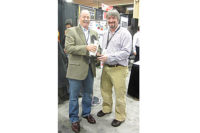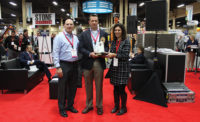With this issue, we celebrate 30 years of publishing Stone World and covering the international stone industry. We have navigated the waters through many changes, periods of rapid growth, and one of the worst recessions in modern history. In this 30th year, we also lost one of our own, editor Michael Reis, whom we honored in our March 2014 issue.
When we started publishing the magazine in November 1984, Stone World primarily focused on factories that were manufacturing stone, the quarries from which the stone came and the equipment that enabled the manufacturers to cut stone more economically — making stone a more competitive building product. The industry has evolved and grown since those early days, and our magazine has adapted and changed with it, hopefully all the while providing information that helps stone businesses of all types succeed.
CHECK OUT THE ANNIVERSARY PAGE
The birth of Stone World
The genesis of Stone World is a classic story of American capitalism. Mike and Stephanie Lench started the publication without borrowing a dime and held staff meetings in their kitchen. Mike Lench was a veteran editor of trade magazines who grew disenchanted with his former employer and decided he wanted to start his own magazine. A close personal friend owned a stone importing business and mentioned that there was no publication serving his industry at that time. It was a publisher’s dream. Mike traveled to Italy and met with the major stone exporters and equipment manufacturers there, and then returned home to meet with U.S. stone importers, distributors and equipment manufacturers to learn about their businesses. He brought in a staff of publishing professionals, including our current European advertising manager, Dee Wakefield, and he enlisted his wife, Stephanie, who had mastered many careers by that time, to run the advertising sales.
In October of 1985, John Sailer joined the Stone World staff and he was named editor in 1991, leading our editorial direction through 1995. In the late 1980s, the climate was very different in the stone industry. It was not yet an industry based on the kitchen countertop — we were covering tile line installations, not CNC edge profiling machines. Our readership was very different as well, with our largest group of subscribers comprised of architects and designers. We reached only about 1,500 fabricators, and many of them were not the same types of companies we think of today when we talk about stone fabricators.
Since stone had not yet become a common kitchen component, where was it all going? Until the 1990s, stone was mainly being installed in corporate offices, institutional buildings and commercial settings — and only the high end of residential projects. We often covered these projects by asking architects about their design goals and choice of stone for the particular job, as well as about the process of working with their stone supplier. One of the highlights of those early years was when we interviewed Phillip Johnson, the iconic architect of the 20th century, and featured him and his partner, John Burgee, on our cover. We were lucky enough to interview some of the biggest names in architecture over the years, and we celebrated the work of these great designers in our pages.
Developing an international market
I joined the staff in 1988 to help sell ad space in Stone Worldand to help grow a new publication our parent company (Tradelink Publishing) had launched, called Tile World. It was an exciting time to join Stone World, since the world was becoming smaller and the time was right to start developing new markets outside of the U.S. and Europe. Mike sent me to Brazil and Argentina to start developing those markets, and besides being an absolute blast for a 25-year-old kid to spend a weekend in Rio de Janeiro or Buenos Aires, it was a brilliant strategy. Brazil is one of the most important stone-producing nations and is now a large part of our business. I have visited much of this amazing country every year since 1990.
The next logical place for expansion was India, so we attended two stone fairs in 1992, and traveled to visit both the new and established factories. With the trend toward unpredictable granites with lots of movement, these two nations became important sources of stone and huge markets for machinery exports. Brazil’s government allowed foreign machinery in without the exorbitant tariffs of the past beginning in 1989, while the government in India was offering subsidies to 100% Export Oriented Units, fueling the sale of equipment to establish large-scale manufacturing operations.
Becoming the voice of the fabricator
As the industry changed, Stone World adapted with it. In 1993, Michael Reis joined our editorial staff and he was named Stone World’s third editor in 1995. One of the earliest features of Mike’s tenure was memorable and proved to be a harbinger of things to come. The article was about the sudden and drastic decrease in large-scale stone projects and the opulent lobbies of the past decade, and talked about stone moving into the residence. Stone was suddenly a realistic option for the middle-class homeowner, and this was all fueled by the advancing technology that made stone a much more affordable product. Hand-held routers became the rage and CNC sawing was the new “must-have” technology for fabrication shops, which were opening at a rapid pace. Under Mike’s direction, Stone World soon became the voice of the stone fabricator, focusing on their businesses as well as the equipment and tooling they needed for their daily operations. Our circulation reflected these changes as well, as we shifted from a readership of architects to a circulation comprised of stone fabricators — increasing in number from 1,500 to 12,000 between 1984 and 1997.
In 1994, Tradelink Publishing sold Stone Worldto BNP Media, our current owners. Shortly afterwards, Jennifer Adams joined Michael Reis in 1996 to form our longest-tenured editorial team, and she was named editor of our sister publication, Contemporary Stone & Tile Design in 2001. Recently, she also became editor of TILE Magazinein 2011. Together, they visited fabrication shops all over the country, quarries all over the world and trade shows wherever they occurred. This editorial team was together until February of this year, when Michael Reis died suddenly, leaving a hole in our staff and in the industry. Mike wasn’t just our editor; he was truly the industry’s leading advocate and an expert on fabricating technology.
Stone World lives on, but much of Mike’s imprint will remain on our publication after all of us are gone. One such example are the Fabricator Case Studies that we began publishing in the mid-1990s, hoping to provide some best practices along the way, but most importantly, offering fabricators a chance to learn about each other and benefit from their peer’s experiences.
Providing information through various vehicles
In 2006, Stone World launched a series of fabrication workshops, traveling around the country and meeting fabricators from almost every city. We learned as much as they did, and it was a very successful model. But as the growth came to a halt in 2007, and the economy at large began spiraling downwards in 2008, contraction set in and registration dropped. We partnered with the Marble Institute of America (MIA) on a series of workshops and networking events that we still produce today.
We have also formed a partnership with the Building Stone Institute (BSI) to publish Building Stone Magazine, which comes out twice a year. The first issue was printed in the fall of 2011 and this is something we still are proud to be involved with today. Our staff produces an informative and visually inspiring book for the architect and design community.
In addition to our print issues, Stone Worldhas been leading the digital charge since the late 1990s, and now we reach the industry through our website, www.stoneworld.com, our bi-weekly eNewsletter and our digital editions. The industry is also embracing the digital world and most products used in the shop and in the warehouse are driven by computers. “The Digital Shop” is one of the most popular topics in our business and digital technological advances are introduced every year. The ability to cut more precisely, more efficiently and quicker will continue to spur industry growth, and these technological advancements will allow stone professionals to accomplish more intricate designs.
The sustainability movement has spurred an industry movement to create best practices, and the Natural Stone Council (NSC), a group of stone industry associations and leaders, has developed an important standard, ANSI/NSC-373. This new standard will allow quarriers, processors and fabricators of natural stone who consistently meet or exceed the standards to label and promote their stone products as “certified Genuine Stone®.” There is no denying that we as an industry need to continue to move towards more environmentally responsible quarrying and manufacturing, and I believe the NSC is making important strides towards this goal. It won’t be long before consumers’ buying decisions will be shaped more specifically by environmental concerns, and we need to get ahead of the curve at positioning our products as sustainably-produced building materials.
As we begin another decade covering and promoting natural stone, we seek to grow and continue to deliver the news and inform our readers in print, online, on mobile devices and in ways we don’t currently envision — and we hope you will be along for the ride. Thanks for your support and for reading.

























